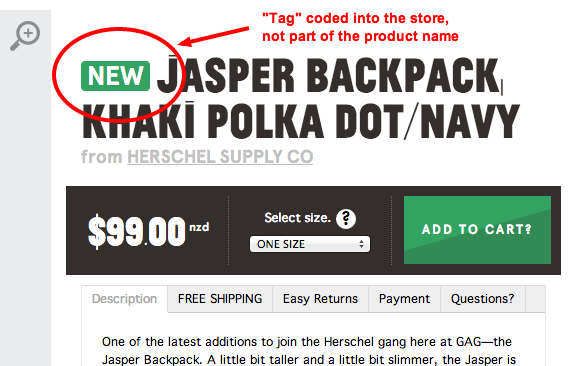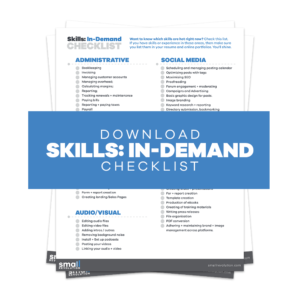The aim of this guide is to help you write good quality product titles that are of great value to search engine and useful to readers.
The product title is critically important for a store’s success.
Search engines compare a customer’s query with the name of our product and then decide whether it is a good match. If a customer is searching for a “Red Fluffy Boxing Shoe” then it is more likely that our products will be shown in the search results if product titles have some matching words.
To write a good product title you will need to have some understanding of the product on offer and how it fits into the context of the entire product range on offer. This will help you to add good keywords/synonyms and help the customer find what they’re looking for.
Writing a good product title takes practice.
Watch this screencast to get an overview of the entire process. You can apply this method to any product title writing. The product used in the screencast is just an example.
Step 1: Decide On A Consistent Product Title Format
The product title should fit closely with the manufacturer’s title but doesn’t have to be identical.
The title will usually follow a standard sequence of words. The brand name followed by product type, some characteristics and then perhaps a size or other unique characteristic.
Example 1 – Shelta Avalon Vinyl Beach Umbrella 200cm UPF50
- Shelta is the brand name.
- Avalon is the name of this actual product.
- Vinyl denotes a unique characteristic about this product that sets it apart from others in the range.
- Beach Umbrella is the type of thing (category) it is.
Example 2 – Apple iPhone 5s With Bumper
- Apple is the brand name
- iPhone identifies what the product is
- 5s identifies a unique characteristic and type of product
- with Bumper indicates that this product comes with an additional thing/accessory
- Because the product name contains the word “phone” we don’t need to add “phone” at the end of the product name.
Step 2: Avoid Using “New” in the product title.
eBay Store Owners will often use “New” in the title to denote that the product is “new” as opposed to being a second-hand item.
This is particularly relevant for the eBay marketplace as it began its life as a second-hand platform. Not so relevant for an online store with brand new products!
In your online store, you might sometimes be tempted to use the word “New” in the product title to show people that these are the latest products in your inventory. When you include the word “new” a customer will read it as you intended, but the search engines will see it as part of the product name.
Keep in mind that you need to write for both your customers and Google. Your customers are able to interpret and make meaning from your writing whereas the search engines are robots trying to emulate human behavior. It is a fine balance to achieve.
It is important that once you write a product title you either don’t ever change it again or very rarely.
Shopping cart software will often use the product title as the basis for the URL structure. If you do change the product name in order to remove “new” (when it’s no longer new!) then the shopping cart software will also update the URL.
For example:
- http://www.goodasgold.co.nz/collections/herschel-supply-co/products/new-jasper-backpack-khaki-polka-dot-navy
- http://www.goodasgold.co.nz/collections/herschel-supply-co/products/jasper-backpack-khaki-polka-dot-navy
Changing the product title has a cascading effect. When you change the product title then the URL will usually change. This means that the old URL will have been indexed by the search engines.
The next time the search robots visit your store they will no longer be able to find the product with the changed title/URL. The search robots are not intelligent enough to ‘understand’ that you simply removed the word “new“.
If you do change the product titles then you will need to set up 301 Redirects in your store. This will help the search engines find the changed pages/URL.

In the above example, you’ll see that the word “NEW” has been added next to the product title. This store will have used a “tag” to insert the word automatically into the page template, but without connecting it directly to the product title name.
You will need to speak to your Web Developer about updating your shopping cart template with a “tag” in order to achieve this effect.
Step 3: Avoid Using Punctuation In Your Product Titles
This one is a little hard to explain and find examples for but suffice to say avoid including punctuation in your product titles.
Some shopping carts and some search engines will replace the punctuation with escape sequences.
This means that your title ends up not necessarily making sense to your customers when they read the title in the search results.
The punctuation is converted, by the search engine or shopping cart, into a seemingly unintelligible sequence of random characters.
Punctuation marks that are often used, but shouldn’t, include: ! * – . _ or ( )
It is okay to use a slash mark for denoting a two-tone product. For example “brown/black” in “Chanel Pink/Silver Leather Handbag“.
Step 4: Add More Value To The Title
Example 1 – “Como 8 Person Family Canvas Tent” is more useful to a customer than “Como Canvas Tent“.
With the addition of descriptive words, the customer is able to quickly read that not only is this a tent made of canvas, but it is also suitable for up to 8 people, and that means possibly a family.
However, these are not just random words that have been added to the product title. For example, we would never add “best” or “popular” or non-factual words to the product title. Don’t add opinions to titles, just facts.
The most useful “added value” words to add to product titles are keywords. We sometimes also refer to these as synonyms.
A “keyword” is a label used by search engines to categorize all the information on the Internet. In this example, you’ll notice that we have used both “8 person” and “family”. These two keyword phrases could be interchanged as they have relatively similar meanings for the customer.
Example 2 – “OZtrail Deluxe Gazebo 3m x 3m Portable Shade” is more useful than “OZtrail Deluxe Gazebo“.
By adding in the dimensions “3m x 3m” we are helping customers to understand the size of the product. And by adding “Portable Shade” we are helping customers to understand that this is not a wooden gazebo that sits in the backyard, but is instead a lightweight metal and fabric canopy structure.
This example shows that sometimes it is important to add a keyword/synonym to the heading title in order to give the primary word (gazebo) more context.
Do not include too many keyword synonyms eg: “Como 8 Person Man Family Large Canvas Tent Tents“. This looks like spam to both search engines and customers.
Step 5: Be Consistent With Your Syntax
Write The Product Titles Like This With Uppercase At The Beginning Of Each Word. Keep It Consistent.
Or create your own rule for consistently creating each product title, and make sure you include it in your store’s Knowledge Base.
If you are using size, such as 3 meters, keep it consistent every single time. Do not use “3 meters” in one title and “3m” in another.
- Good example: OZtrail Deluxe Gazebo 3m x 3m Marquee
- Bad example: OZtrail deluxe gazebo
- Bad example: OZtrail 2m x 3 meters Gazebo
Final Checklist
To write product titles that search engines would love, make sure you:
- Decide on a consistent Product Title format that you can use for all products in your store
- Avoid using “New” in product titles, instead, add it as a tag to your product title
- Avoid using punctuations in the Product Titles as these are converted into an unintelligible sequence of random characters
- Add more value to the title by adding useful details
- And, be consistent with your syntax


